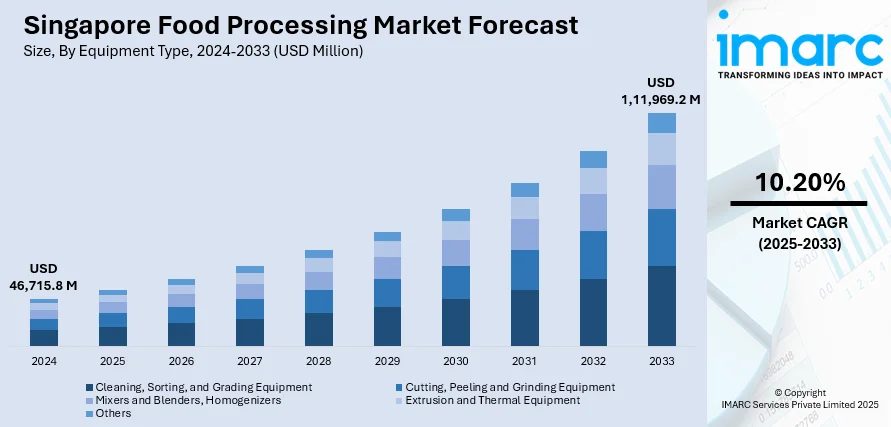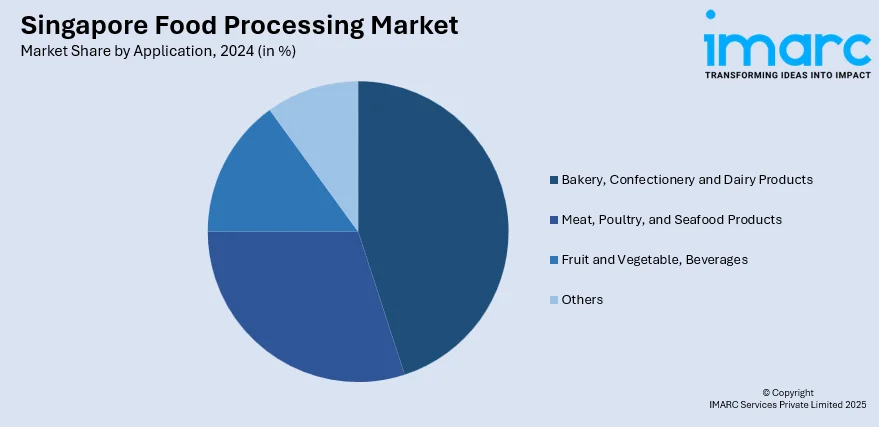
Singapore Food Processing Market Size, Share, Trends and Forecast by Equipment Type, Category, Application, and Region, 2025-2033
Singapore Food Processing Market Overview:
The Singapore food processing market size reached USD 46,715.8 Million in 2024. Looking forward, IMARC Group expects the market to reach USD 1,11,969.2 Million by 2033, exhibiting a growth rate (CAGR) of 10.20% during 2025-2033. The market is driven by the increasing consumer demand for processed foods, rising government support and the imposition of favorable regulations, rapid technological advancements, heightened export opportunities facilitated by strategic trade agreements, and significant investment in research and development (R&D).
|
Report Attribute
|
Key Statistics
|
|---|---|
|
Base Year
|
2024
|
|
Forecast Years
|
2025-2033
|
|
Historical Years
|
2019-2024
|
|
Market Size in 2024
|
USD 46,715.8 Million |
|
Market Forecast in 2033
|
USD 1,11,969.2 Million |
| Market Growth Rate 2025-2033 | 10.20% |
Singapore Food Processing Market Trends:
Growing Demand for Processed Foods
The market for food processing in Singapore is expanding as a result of rising consumer demand for processed meals. This is attributable to customers' changing lifestyles, urbanization, and increased disposable incomes. People are choosing more convenient, ready-to-eat (RTE), and easy-to-prepare food products since they lead busy lives. In response to this trend, food processing businesses are creating a variety of RTE items, including packaged drinks, snacks, and frozen dinners. Furthermore, consumers who prioritize their health are looking for processed meals that meet their dietary requirements and provide nutritional advantages. Therefore, the demand for functional foods that are fortified with vitamins and minerals is on the rise.

To get more information on this market, Request Sample
Rising Government Support and Imposition of Regulations
The government's initiative towards improving the food processing sector has been a major factor in the market expansion. Accordingly, the government has been adopting a number of programs, regulations, and incentives in this industry to encourage innovation, guarantee food security, and advance sustainability. For example, the Agri-Food Cluster Transformation (ACT) Fund, established by the Singapore Food Agency (SFA), provides funds to assist regional businesses with deploying cutting-edge technology and increasing production. Companies are encouraged to invest in research and development (R&D) for innovative processing methods and products through this financial support. In addition, the country is known for its stringent food safety standards enforced by the SFA. These regulations make sure that food processing companies adhere to high-quality standards, which helps in building consumer trust and increase the reputation of local products in markets across the globe.
Rapid Technological Advancements
The market is expanding at a faster rate owing to the growing technical developments that improve productivity, cut expenses, and allow for the creation of novel goods. In order to streamline processes and save labor costs, automation and robots are being used progressively in the food processing industry. These technological advancements assist in improving industrial processes' accuracy, velocity, and consistency. For instance, robotic arms and automated packaging systems play a role in guaranteeing high standards of quality and increased productivity. Additionally, this industry is evolving due to the advancements in artificial intelligence (AI) and machine learning (ML), which are allowing predictive maintenance, streamlining supply chain management, and enhancing quality control.
Singapore Food Processing Market News:
- In June 2023, Tee Yih Jia partnered with ABB to digitalize its energy management. The company's popular Spring Home branded spring roll pastry, roti paratha, dim sum, samosa, and other Asian specialties are sold to consumers around the world. This company's latest $450 million production facility in Senoko, Singapore, is using data and Industry 4.0 technology to achieve continuous improvements in its resource efficiency and cost savings.
- In March 2023, Hindustan Unilever Ltd sold its non-core atta brand 'Annapurna' and salt business under the brand 'Captain Cook' to a Singapore-based company, Reactivate Brands International (RBI), for Rs 604 million (US$7.37 million).
Singapore Food Processing Market Segmentation:
IMARC Group provides an analysis of the key trends in each segment of the market, along with forecasts at the country level for 2025-2033. Our report has categorized the market based on equipment type, category, and application.
Equipment Type Insights:
- Cleaning, Sorting, and Grading Equipment
- Cutting, Peeling and Grinding Equipment
- Mixers and Blenders, Homogenizers
- Extrusion and Thermal Equipment
- Others
The report has provided a detailed breakup and analysis of the market based on the equipment type. This includes cleaning, sorting, and grading equipment, cutting, peeling and grinding equipment, mixers and blenders, homogenizers, extrusion and thermal equipment, and others.
Category Insights:
- Semi-Automated
- Fully Automated
A detailed breakup and analysis of the market based on the category have also been provided in the report. This includes semi-automated and fully automated.
Application Insights:

- Bakery, Confectionery and Dairy Products
- Meat, Poultry, and Seafood Products
- Fruit and Vegetable, Beverages
- Others
The report has provided a detailed breakup and analysis of the market based on the application. This includes bakery, confectionery and dairy products, meat, poultry, and seafood products, fruit and vegetable, beverages, and others.
Regional Insights:
- North-East
- Central
- West
- East
- North
The report has also provided a comprehensive analysis of all the major regional markets, which include North-East, Central, West, East, and North.
Competitive Landscape:
The market research report has also provided a comprehensive analysis of the competitive landscape. Competitive analysis such as market structure, key player positioning, top winning strategies, competitive dashboard, and company evaluation quadrant has been covered in the report. Also, detailed profiles of all major companies have been provided.
Singapore Food Processing Market Report Coverage:
| Report Features | Details |
|---|---|
| Base Year of the Analysis | 2024 |
| Historical Period | 2019-2024 |
| Forecast Period | 2025-2033 |
| Units | Million USD |
| Scope of the Report | Exploration of Historical Trends and Market Outlook, Industry Catalysts and Challenges, Segment-Wise Historical and Future Market Assessment:
|
| Equipment Types Covered | Cleaning, Sorting, and Grading Equipment, Cutting, Peeling and Grinding Equipment, Mixers and Blenders, Homogenizers, Extrusion and Thermal Equipment, Others |
| Categories Covered | Semi-Automated, Fully Automated |
| Applications Covered | Bakery, Confectionery and Dairy Products, Meat, Poultry, and Seafood Products, Fruit and Vegetable, Beverages, Others |
| Regions Covered | North-East, Central, West, East, North |
| Customization Scope | 10% Free Customization |
| Post-Sale Analyst Support | 10-12 Weeks |
| Delivery Format | PDF and Excel through Email (We can also provide the editable version of the report in PPT/Word format on special request) |
Key Questions Answered in This Report:
- How has the Singapore food processing market performed so far and how will it perform in the coming years?
- What is the breakup of the Singapore food processing market on the basis of equipment type?
- What is the breakup of the Singapore food processing market on the basis of category?
- What is the breakup of the Singapore food processing market on the basis of application?
- What are the various stages in the value chain of the Singapore food processing market?
- What are the key driving factors and challenges in the Singapore food processing?
- What is the structure of the Singapore food processing market and who are the key players?
- What is the degree of competition in the Singapore food processing market?
Key Benefits for Stakeholders:
- IMARC’s industry report offers a comprehensive quantitative analysis of various market segments, historical and current market trends, market forecasts, and dynamics of the Singapore food processing market from 2019-2033.
- The research report provides the latest information on the market drivers, challenges, and opportunities in the Singapore food processing market.
- Porter's five forces analysis assist stakeholders in assessing the impact of new entrants, competitive rivalry, supplier power, buyer power, and the threat of substitution. It helps stakeholders to analyze the level of competition within the Singapore food processing industry and its attractiveness.
- Competitive landscape allows stakeholders to understand their competitive environment and provides an insight into the current positions of key players in the market.
Need more help?
- Speak to our experienced analysts for insights on the current market scenarios.
- Include additional segments and countries to customize the report as per your requirement.
- Gain an unparalleled competitive advantage in your domain by understanding how to utilize the report and positively impacting your operations and revenue.
- For further assistance, please connect with our analysts.
 Request Customization
Request Customization
 Speak to an Analyst
Speak to an Analyst
 Request Brochure
Request Brochure
 Inquire Before Buying
Inquire Before Buying




.webp)




.webp)












